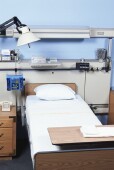Few studies compare effectiveness of disinfecting methods and monitoring strategies
TUESDAY, Aug. 11, 2015 (HealthDay News) — Methods for cleaning, disinfecting, and monitoring the cleanliness of hospital room surfaces to prevent health care-associated infections (HAIs) have been reviewed. The findings were published online Aug. 11 in the Annals of Internal Medicine.
Jennifer H. Han, M.D., from the Perelman School of Medicine at the University of Pennsylvania in Philadelphia, and colleagues conducted a literature review examining current methods of cleaning, disinfecting, and monitoring the cleanliness of patient rooms. The authors also examined contextual factors that may affect implementation and effectiveness of cleaning. They included studies examining surface contamination, colonization, or infection with Clostridium difficile, methicillin-resistant Staphylococcus aureus, and vancomycin-resistant enterococci.
The researchers identified 80 studies (76 primary studies and four reviews), of which 49 examined cleaning methods, 14 assessed monitoring strategies, and 17 related to challenges or facilitators to implementation. Five studies were randomized, controlled trials. The most commonly assessed outcome was surface contamination. Comparative effectiveness studies of disinfecting methods and monitoring strategies were uncommon. Future research should assess and compare newly emerging strategies, and should also evaluate patient-centered outcomes when possible.
“In summary, our review of the literature indicates an increased interest in environmental cleaning and disinfecting for the prevention of HAIs,” the authors write. “Future research on environmental cleaning that addresses these limitations and evidence gaps will be critical for informing real-world interventions for reducing the risk for HAIs in the hospital setting.”
Full Text
Editorial (subscription or payment may be required)
Copyright © 2015 HealthDay. All rights reserved.








